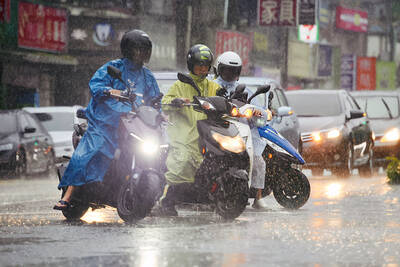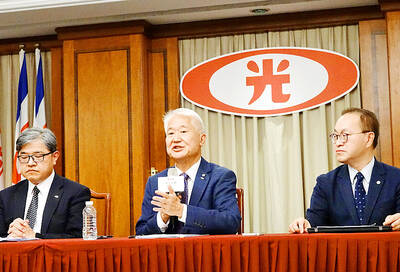The Ministry of National Defense is to build a new automated production line with a NT$14 billion (US$431.23 million) budget to meet increasing demand for 155mm artillery shells, a source said yesterday.
The Russia-Ukraine war has created a defense demand that has galvanized many Western nations as well as Ukraine into restarting or building 155mm artillery shell production lines, while the US last year proposed bilateral cooperation in manufacturing such shells.
A government source with knowledge of the matter, who asked to remain anonymous, yesterday said that the ministry has planned a budget of NT$14 billion to construct a new automated production line at Factory 202 of the Armaments Bureau to produce 155mm shells.

Photo: Chang Hsuan-tse, Taipei Times
Part of the budget would also be used to optimize existing shell production lines to boost production capacity, he said.
Factory 202 has already been manufacturing 155mm shells, but its capacity was not fully utilized as the artillery batteries of the army and the marine corps did not frequently conduct live-fire drills and did not consume much of the ammunition, the source said.
However, a new automated production line is required and existing facilities must be enhanced, as demand is expected to surge after the US-Taiwan manufacturing cooperation agreement begins, he said.
If the proposal is passed by both the Executive Yuan and the legislature, it is projected to be a five-year project that runs from next year through 2030 with a budget of about NT$14 billion, the source said.
The new production line would prioritize the manufacturing of 155mm shells and aid the production of 120mm shells for M1A2T tanks, he said.
It would also be used to help meet increasing demand for M230 chain gun shells, the source said.
The legislature’s Foreign Affairs and National Defense Committee on April 17 visited Factory 202 along with Lieutenant General Yang Chi-jung (楊基榮) to learn more about the ammunition production process and the ministry’s production capacity planning, he said.
During the visit, committee convener Legislator Puma Shen (沈伯洋) said that more on-site inspections would be arranged to help the legislature understand the development of the national defense industry.
Ammunition production capacity underlies the maintenance of overall combat power, he said, adding that he expects the committee to help the ministry boost combat readiness and the defense industry’s resilience.

The combined effect of the monsoon, the outer rim of Typhoon Fengshen and a low-pressure system is expected to bring significant rainfall this week to various parts of the nation, the Central Weather Administration (CWA) said. The heaviest rain is expected to occur today and tomorrow, with torrential rain expected in Keelung’s north coast, Yilan and the mountainous regions of Taipei and New Taipei City, the CWA said. Rivers could rise rapidly, and residents should stay away from riverbanks and avoid going to the mountains or engaging in water activities, it said. Scattered showers are expected today in central and

COOPERATION: Taiwan is aligning closely with US strategic objectives on various matters, including China’s rare earths restrictions, the Ministry of Foreign Affairs said Taiwan could deal with China’s tightened export controls on rare earth metals by turning to “urban mining,” a researcher said yesterday. Rare earth metals, which are used in semiconductors and other electronic components, could be recovered from industrial or electronic waste to reduce reliance on imports, National Cheng Kung University Department of Resources Engineering professor Lee Cheng-han (李政翰) said. Despite their name, rare earth elements are not actually rare — their abundance in the Earth’s crust is relatively high, but they are dispersed, making extraction and refining energy-intensive and environmentally damaging, he said, adding that many countries have opted to

People can preregister to receive their NT$10,000 (US$325) cash distributed from the central government on Nov. 5 after President William Lai (賴清德) yesterday signed the Special Budget for Strengthening Economic, Social and National Security Resilience, the Executive Yuan told a news conference last night. The special budget, passed by the Legislative Yuan on Friday last week with a cash handout budget of NT$236 billion, was officially submitted to the Executive Yuan and the Presidential Office yesterday afternoon. People can register through the official Web site at https://10000.gov.tw to have the funds deposited into their bank accounts, withdraw the funds at automated teller

CONCESSION: A Shin Kong official said that the firm was ‘willing to contribute’ to the nation, as the move would enable Nvidia Crop to build its headquarters in Taiwan Shin Kong Life Insurance Co (新光人壽) yesterday said it would relinquish land-use rights, or known as surface rights, for two plots in Taipei’s Beitou District (北投), paving the way for Nvidia Corp to expand its office footprint in Taiwan. The insurer said it made the decision “in the interest of the nation’s greater good” and would not seek compensation from taxpayers for potential future losses, calling the move a gesture to resolve a months-long impasse among the insurer, the Taipei City Government and the US chip giant. “The decision was made on the condition that the Taipei City Government reimburses the related